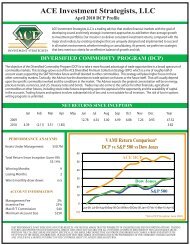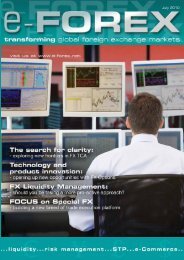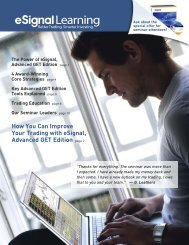Create successful ePaper yourself
Turn your PDF publications into a flip-book with our unique Google optimized e-Paper software.
FEATURES<br />
substantial amount of money to be made in the FX<br />
market and that is what is fundamentally driving the<br />
demand for these services at the end of the day.”<br />
“Increasingly market players are interested in FX since<br />
it is market place where there is uncaptured alpha,<br />
depending on the currency pair and what type of<br />
strategy traders are looking at. As such, it continues to<br />
present a lot of untapped opportunities,” notes New<br />
York-based Doe.<br />
From an historical data perspective, traders came to<br />
Thomson Reuters for data to initiate back testing, as<br />
the firm has had a fairly dominant position in the FX<br />
market. He adds: “Tick data is absolutely essential for<br />
back testing and going live [with an algorithmic<br />
strategy], simply because of the high frequency nature<br />
of FX trading.”<br />
Kohler says in relation to recent ICAP enhancements<br />
to the quality and breadth of data being offered:<br />
“We’re undertaking this on an ongoing basis and<br />
continually investing in the area. Compared to the<br />
historical data that we were releasing just a few years<br />
ago, today it’s much deeper and richer. This is<br />
specifically because we’re able to store and tag<br />
[instruments identifiers] to a far more granular level.”<br />
ICAP also lay claim to offering probably the “most<br />
granular” real-time data output through their ‘Live’<br />
feed. A year ago, ‘Live’ was providing four updates per<br />
second, but since before summer 2009, the frequency<br />
Emmanuel Doe<br />
“Tick data is absolutely essential for back testing and<br />
going live [with an algorithmic strategy], simply because<br />
of the high frequency nature of FX trading”<br />
68 | january 2010 e-FOREX<br />
>>><br />
was increased to 10 updates per second. (The move<br />
reflects developments in the market data feeds for the<br />
EBS FX platform).<br />
Usage<br />
Historical tick data is used primarily for program<br />
and/or automated trading, portfolio management and<br />
valuations. It also plays a vital role in supporting the<br />
<strong>com</strong>pliance, accounting and audit functions of<br />
financial institutions.<br />
Philip Brittan, global business manager for FX at<br />
Bloomberg, confirms that the need for algorithmic FX<br />
trading strategies, FX Quant research, regulatory<br />
<strong>com</strong>pliance/ trade validation requirements are all “valid<br />
reasons” driving more usage of historical FX data.<br />
“High-frequency algorithmic trading is the only driver<br />
that truly requires tick-by-tick data, so that<br />
undoubtedly accounts for the largest volume of FX<br />
data being consumed these days,” he says.<br />
Jim Foster, Global Head of Product Strategy, FXall says<br />
in addition to algo traders wanting historical tick data<br />
to build and back-test models, it can also be required<br />
for benchmarking purposes.“Occasionally highfrequency<br />
algo traders want our historical market data<br />
to benchmark the system speed to monitor how fast we<br />
receive and distribute movements in the market in<br />
<strong>com</strong>parison to other data they are monitoring,” he says.<br />
Furthermore, institutional investors can need the ability<br />
to benchmark pricing for control and <strong>com</strong>pliance<br />
purposes. Foster indicates that more and more clients<br />
are asking for “sophisticated reporting” to understand<br />
exactly where the market was at the time of execution<br />
to ensure they were benchmarked properly.<br />
For institutional asset managers who have a need to<br />
analyse execution quality, FXall timestamps trades to the<br />
millisecond when they receive the requirement - at the<br />
time it is placed into the market - on each quote<br />
provided by the selected banks.<br />
“On execution,” he explains. “We allow a firm to<br />
analyse the execution rate versus both external<br />
benchmarks, and FXall prices. And, the availability of<br />
historical data includes similarly rigorous timestamps on<br />
each quote.”<br />
Sourcing and storage issues<br />
In terms of the issues that FX trading firms need to<br />
consider with regard to sourcing and storing of<br />
historical FX data, ICAP’s Kohler notes that in terms<br />
of infrastructure, hardware and architecture, many










